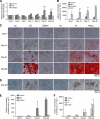Microcalcifications in breast cancer: novel insights into the molecular mechanism and functional consequence of mammary mineralisation
- PMID: 22233923
- PMCID: PMC3273345
- DOI: 10.1038/bjc.2011.583
Microcalcifications in breast cancer: novel insights into the molecular mechanism and functional consequence of mammary mineralisation
Abstract
Background: Mammographic microcalcifications represent one of the most reliable features of nonpalpable breast cancer yet remain largely unexplored and poorly understood.
Methods: We report a novel model to investigate the in vitro mineralisation potential of a panel of mammary cell lines. Primary mammary tumours were produced by implanting tumourigenic cells into the mammary fat pads of female BALB/c mice.
Results: Hydroxyapatite (HA) was deposited only by the tumourigenic cell lines, indicating mineralisation potential may be associated with cell phenotype in this in vitro model. We propose a mechanism for mammary mineralisation, which suggests that the balance between enhancers and inhibitors of physiological mineralisation are disrupted. Inhibition of alkaline phosphatase and phosphate transport prevented mineralisation, demonstrating that mineralisation is an active cell-mediated process. Hydroxyapatite was found to enhance in vitro tumour cell migration, while calcium oxalate had no effect, highlighting potential consequences of calcium deposition. In addition, HA was also deposited in primary mammary tumours produced by implanting the tumourigenic cells into the mammary fat pads of female BALB/c mice.
Conclusion: This work indicates that formation of mammary HA is a cell-specific regulated process, which creates an osteomimetic niche potentially enhancing breast tumour progression. Our findings point to the cells mineralisation potential and the microenvironment regulating it, as a significant feature of breast tumour development.
Conflict of interest statement
The authors declare no conflict of interest.
Figures







Similar articles
-
Microcalcifications in breast cancer: Lessons from physiological mineralization.Bone. 2013 Apr;53(2):437-50. doi: 10.1016/j.bone.2013.01.013. Epub 2013 Jan 18. Bone. 2013. PMID: 23334083 Review.
-
Deposition of calcium in an in vitro model of human breast tumour calcification reveals functional role for ALP activity, altered expression of osteogenic genes and dysregulation of the TRPM7 ion channel.Sci Rep. 2019 Jan 24;9(1):542. doi: 10.1038/s41598-018-36496-9. Sci Rep. 2019. PMID: 30679450 Free PMC article.
-
Oxalate induces breast cancer.BMC Cancer. 2015 Oct 22;15:761. doi: 10.1186/s12885-015-1747-2. BMC Cancer. 2015. PMID: 26493452 Free PMC article.
-
Calcium hydroxyapatite promotes mitogenesis and matrix metalloproteinase expression in human breast cancer cell lines.Mol Carcinog. 2001 Nov;32(3):111-7. doi: 10.1002/mc.1070. Mol Carcinog. 2001. PMID: 11746823
-
Microcalcifications in breast cancer: From pathophysiology to diagnosis and prognosis.Biochim Biophys Acta Rev Cancer. 2018 Apr;1869(2):310-320. doi: 10.1016/j.bbcan.2018.04.006. Epub 2018 Apr 21. Biochim Biophys Acta Rev Cancer. 2018. PMID: 29684522 Review.
Cited by
-
Raman spectroscopic sensing of carbonate intercalation in breast microcalcifications at stereotactic biopsy.Sci Rep. 2015 Apr 30;5:9907. doi: 10.1038/srep09907. Sci Rep. 2015. PMID: 25927331 Free PMC article.
-
Cellular plasticity in bone metastasis.Bone. 2022 May;158:115693. doi: 10.1016/j.bone.2020.115693. Epub 2020 Oct 15. Bone. 2022. PMID: 33069922 Free PMC article.
-
Breast Tumor Microcalcification Induced by Bone Morphogenetic Protein-2: A New Murine Model for Human Breast Tumor Diagnosis.Contrast Media Mol Imaging. 2018 Nov 11;2018:2082154. doi: 10.1155/2018/2082154. eCollection 2018. Contrast Media Mol Imaging. 2018. PMID: 30534026 Free PMC article.
-
Clinical and pathological features analysis of invasive breast cancer with microcalcification.Cancer Med. 2023 May;12(10):11351-11362. doi: 10.1002/cam4.5848. Epub 2023 Mar 27. Cancer Med. 2023. PMID: 36971046 Free PMC article.
-
New insights into breast microcalcification for poor prognosis: NACT cohort and bone metastasis evaluation cohort.J Cancer Res Clin Oncol. 2023 Aug;149(10):7285-7297. doi: 10.1007/s00432-023-04668-4. Epub 2023 Mar 14. J Cancer Res Clin Oncol. 2023. PMID: 36917189 Free PMC article.
References
-
- Addison WN, Azari F, Sorensen ES, Kaartinen MT, McKee MD (2007) Pyrophosphate inhibits mineralization of osteoblast cultures by binding to mineral, up-regulating osteopontin, and inhibiting alkaline phosphatase activity. J Biol Chem 282: 15872–15883 - PubMed
-
- Aslakson CJ, Miller FR (1992) Selective events in the metastatic process defined by analysis of the sequential dissemination of subpopulations of a mouse mammary tumor. Cancer Res 52: 1399–1405 - PubMed
-
- Bellahcene A, Merville MP, Castronovo V (1994) Expression of bone sialoprotein, a bone matrix protein, in human breast cancer. Cancer Res 54: 2823–2826 - PubMed
Publication types
MeSH terms
Substances
LinkOut - more resources
Full Text Sources
Other Literature Sources
Medical

